



Continuous Motor Monitoring: Implementation and Value Webinar Will Begin at 12:00 PM EDT
Outline • Standard and technology-based assessment of motor symptoms • Kinesia HomeView overview • Motion sensor rating tremor in a laboratory setting during activities of daily living • Continuous motion sensor rating of tremor at home
Standard Assessment of Involuntary Motor Symptoms Clinician Ratings Patient Diaries • Limited resolution • Compliance • Limited reliability • Recall bias • Placebo effects • Poor self-assessment
Technology-based Assessment Touch Motion Mobile Data Interfaces Sensors Networking Objective, high resolution Remote + measurement access
Clinical Validation - Tremor Published Giuffrida, J. P., Riley, D, Maddux, B, and Heldman, D.A. Clinically deployable Kinesia technology for automated tremor assessment. Movement Disorders 24 (5): 723-730, 2009.
Clinical Validation - Bradykinesia Objective Kinematic features are highly correlated to clinician MBRS Quantification scores Published Heldman, DA; Giuffrida, JP; Chen, R; Payne, M; Mazzella, F; Duker, AP; Sahay, A; Kim, SJ; Revilla, FJ; Espay, AJ. The Modified Bradykinesia Rating Scale for Parkinson’s disease: Reliability and Comparison with Kinematic Measures. Movement Disorders . 2011.
Clinical Validation - Dyskinesia Published Mera, TO, Burack, MA, and Giuffrida, JP. “Quantitative Assessment of Levodopa Induced Dyskinesia Using Automated Motion Sensing Technology”, IEEE-EMBS Proceedings 2012.
Capturing Fluctuations
Pre-defined Tasks Discrete Points in Time In Front of Tablet PC Routine ADLs “Continuously” Anywhere Reduce Patient Burden + Improve Compliance
Challenges in Continuous Tremor Monitoring Movement Non- Episodes of Standardized Variable Motions Duration Discerning Regular Activities from Symptoms
Tremor Assessment During Simulated ADLs • 10 subjects with essential tremor wore motion sensors on the index finger in a laboratory • Performed standardized tasks from the WHIGET tremor rating scale and non- standardized simulated ADL tasks • Tremor rated by movement disorder specialists and by motion sensor system Published Heldman, DA; Jankovic, J; Vaillancourt, DE; Prodoehl, J; Elble, RK; Giuffrida, JP. Essential Tremor Quantification During Activities of Daily Living. Parkinsonism and Related Disorders . 2011.
Tremor Assessment During Simulated ADLs • Mathematical models produced ADL task ratings that correlated well with recent clinician ratings of standardized tasks Published Heldman, DA; Jankovic, J; Vaillancourt, DE; Prodoehl, J; Elble, RK; Giuffrida, JP. Essential Tremor Quantification During Activities of Daily Living. Parkinsonism and Related Disorders . 2011.
Continuous Tremor Assessment at Home • 20 ET subjects wore the motion sensor for up to 10 hours per day on 2 separate days • Completed standardized motion sensor tremor assessments at one-hour intervals to serve as checkpoints Joseph Jankovic, MD Christopher Goetz, MD Olga Waln, MD Sheila Eichenseer, MD Christine Hunter, RN
Continuous Tremor Assessment at Home • Mathematical model uses processed motion sensor data to rate tremor amplitude severity every 12 seconds • 5-minute sliding window used to filter the continuous scores
Continuous Tremor Assessment at Home • Distribution of tremor scores is a quick tool for evaluating effectiveness of changes to therapy • System can also be leveraged to monitor medication dose- response
Conclusions • Tremor can be accurately rated during activities of daily living performed in a laboratory setting • Tremor can be rated on a continuous basis without prior knowledge of activity using a single finger- worn sensor in patients’ homes • Dyskinesia rating is in our pipeline and future work will evaluate continuous dyskinesia monitoring with an optimized sensor suite
Acknowledgements Christopher Goetz, MD Dustin Heldman, PhD Sheila Eichenseer, MD Joseph Giuffrida, PhD Thomas Mera, MS Joseph Jankovic, MD Olga Waln, MD Christine Hunter, RN NIH/NIA 2R44AG034708-02A1 David Vaillancourt, PhD
Questions? Please contact: Christopher Pulliam, PhD Senior Biomedical Engineering Researcher cpulliam@glneurotech.com
Recommend
More recommend